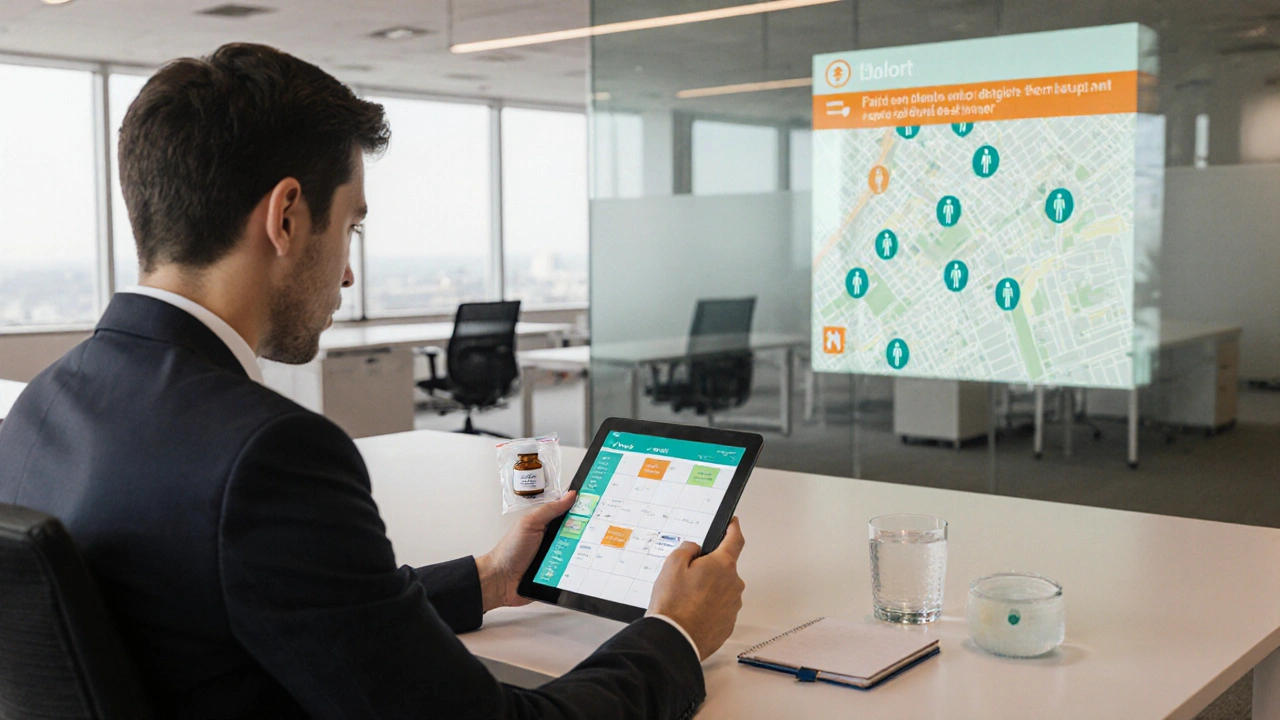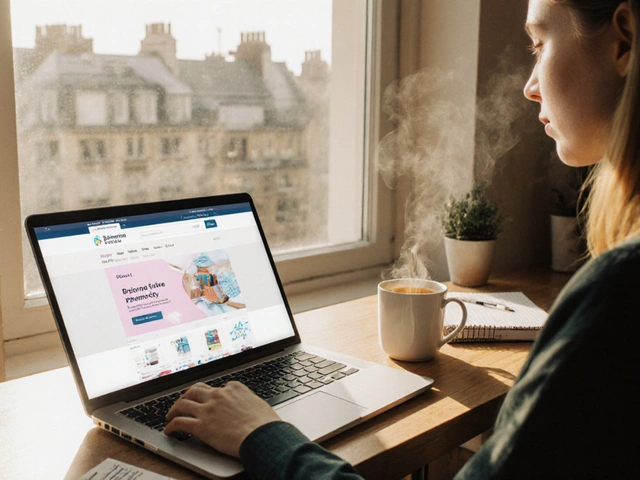Colitis Symptom Management Planner
Medication Reminder
Schedule your medications around your workday to maintain consistent treatment.
Restroom Planning
Identify and map out the nearest restrooms for quick access during flare-ups.
Personalized Action Plan
Workplace Adjustments
Click on each adjustment below to see how it can help manage your colitis symptoms:
Quick Relief Strategies
Medication On Hand
Keep rescue meds in a sealed pouch in your desk drawer.
Hydration Boost
Sip water or electrolyte drinks to replace fluids lost from diarrhea.
Heat Therapy
Use a portable heating pad or warm water bottle for abdominal cramps.
Discreet Excuse
Use a code word or "personal break" to head to the washroom.
Quick Takeaways
- Plan medication timing around meetings and breaks.
- Identify the nearest restroom and keep a backup plan.
- Talk to your manager early about reasonable adjustments.
- Use diet and stress‑relief tools to reduce flare‑ups during the day.
- Keep a simple symptom‑tracking checklist at your desk.
Living with colitis means you’ve got to juggle the unpredictable while keeping up with the daily grind. The good news is that a mix of practical tweaks, open communication, and a few health‑smart habits can turn a stressful workday into a manageable one. Below you’ll find step‑by‑step advice that works whether you’re in an open‑plan office, a remote setup, or a hands‑on job site.
What "Colitis" Means in the Workplace
Colitis is a chronic inflammation of the colon that can cause abdominal pain, urgent bowel movements, and fatigue. It often flares up unpredictably, making it a unique challenge for anyone who spends long hours away from home.
Understanding how the disease behaves helps you pick the right strategies. Most people experience three patterns:
- Frequent mild symptoms that can be controlled with diet and medication.
- Occasional moderate flare‑ups that require a short break from normal duties.
- Severe episodes that may need medical attention and a brief sick‑leave period.
Knowing which pattern you fall into lets you tailor your workplace plan accordingly.
Immediate Relief Tactics for a Sudden Flare‑Up
When symptoms strike mid‑meeting, you need quick, discreet actions:
- Medication on hand: Keep a small, sealed pouch of your rescue meds (e.g., anti‑spasmodics or low‑dose steroids) in your drawer.
- Hydration boost: Sip water or an electrolyte drink to replace fluids lost from diarrhea.
- Heat therapy: A portable heating pad (or a warm water bottle) can calm abdominal cramps in a few minutes.
- Excuse yourself: Use a pre‑agreed code word or simply say you need a "personal break" to head to the washroom.
Having these items in a discreet pouch means you won’t have to scramble through a bag or leave a mess on your desk.
Planning Ahead: Diet, Medication Timing, and Schedule
Long‑term management is about making the day flow around your body’s rhythm.
- Medication timing: If you take a maintenance drug that works best with food, schedule it around lunch or a snack break. Set a phone reminder so you never miss a dose.
- Smart meal prep: Pack low‑fiber, low‑fat meals that are easier on the colon. Keep a stash of easy‑digest snacks (e.g., banana, plain rice cakes) for mid‑morning cravings.
- Flexible break blocks: If your employer offers flexible hours, shift one of the longer breaks to a time when you usually feel a dip in energy.
- Remote‑work contingency: Design a home office space with a private restroom nearby-this can be a lifesaver on a bad day.

Talking to Your Employer and Colleagues
Open communication builds a supportive environment without exposing every detail of your health.
- Pick the right moment: Choose a calm, private meeting rather than a busy hallway.
- Focus on solutions: Explain that you may need quick restroom access or occasional flexible start times, and propose how you’ll keep productivity high.
- Know your rights: In the UK, the Equality Act 2010 protects employees with chronic conditions. Reasonable adjustments-like a nearby restroom or a modified workload-are legal obligations for most employers.
- Document the agreement: A short email recap helps both parties remember the accommodations and avoids future misunderstandings.
Most managers appreciate the transparency and will gladly work with you to keep the team on track.
Workplace Adjustments That Make a Difference
Here are the most common tweaks that have helped people with colitis stay productive:
| Adjustment | Implementation Effort | Impact on Daily Comfort |
|---|---|---|
| Map of nearest restrooms | Low | High - reduces anxiety about finding a bathroom quickly. |
| Flexible start/end times | Medium | Medium - lets you schedule medication around peak energy periods. |
| Ergonomic chair with lumbar support | Low | Low - eases back strain that can aggravate abdominal discomfort. |
| Remote‑work days | High (policy change) | High - provides control over environment and restroom proximity. |
Start with the low‑effort items; they often give the biggest immediate boost.
Stress Management Techniques That Keep Flare‑Ups at Bay
Stress is a well‑known trigger for colitis flare‑ups. Simple habits can keep cortisol levels in check:
- Micro‑break breathing: Every hour, pause for 60 seconds of deep inhalations (4‑2‑4 count).
- Desk‑friendly stretches: Gentle torso twists and seated cat‑cow motions improve digestion.
- Mindful snack routine: Eat slowly, chew thoroughly, and avoid multitasking while eating.
- Digital detox: Turn off non‑essential notifications during focused work blocks to reduce mental clutter.
Even a five‑minute reset can stop a mild symptom from turning into a full‑blown flare.
Quick‑Reference Checklist for the Office
- Pack medication, heating pad, and electrolyte drink in a labeled bag.
- Know the exact locations of the two nearest restrooms.
- Set phone reminders for medication doses and water breaks.
- Have a pre‑written email ready to remind your manager of any agreed accommodations.
- Log any symptom changes in a small notebook; share trends with your gastroenterologist during appointments.
This list fits on a sticky note and can be stuck to the side of your monitor for easy reference.
Frequently Asked Questions
Can I take a break without it looking like I’m slacking off?
Yes. Frame it as a short "wellness break" and keep it under five minutes. Most workplaces appreciate employees who manage their health proactively, as it often leads to steadier productivity.
What if my manager says no to flexible hours?
Refer to the Equality Act 2010, which requires reasonable adjustments for chronic conditions. You can request a formal HR review; many companies prefer to find a compromise rather than risk a legal claim.
Is it okay to keep my medication in a visible drawer?
Absolutely. Keeping meds visible reduces the chance of forgetting doses and signals to you that you’re prepared. Use a discreet, labeled container if you prefer privacy.
How can I handle long meetings without bathroom access?
Ask the organizer if the meeting can include a short break every hour. If that’s not possible, schedule a quick “stand‑up” timer on your phone and politely excuse yourself when needed. Most colleagues understand when you keep it brief.
Do I need to tell all my coworkers about my condition?
No. Share only with those who need to know for safety or accommodation reasons-typically your manager or HR. You control how much detail you disclose.






Jayant Paliwal
5 October, 2025 . 03:31 AM
When confronting the daily grind with colitis, one must first acknowledge the anatomical reality-an inflamed colon that does not discriminate between boardroom and breakroom; consequently, the strategy must be both methodical and mercilessly systematic, employing a schedule that treats medication as a non‑negotiable appointment, much like a conference call with the CEO; consider, for instance, the virtue of mapping every restroom within a 50‑meter radius of your desk, then committing this map to memory as you would a product roadmap, because anxiety over the unknown is a performance killer; furthermore, adopt the habit of a discreet pouch for rescue meds, sealed with a zip that whispers reliability-no one wants a busted packet in a meeting; the ergonomic chair, while seemingly a trivial comfort, actually mitigates musculoskeletal tension that can exacerbate abdominal cramping; do not underestimate the power of a portable heating pad, a silent ally against cramps that can otherwise erupt like a faulty server during peak load; finally, remember to calibrate your water intake, sipping electrolytes as one would sip data packets, ensuring hydration levels remain optimal, thereby reducing the frequency of urgent bathroom trips.
Kamal ALGhafri
16 October, 2025 . 22:11 PM
It is incumbent upon the conscientious worker to perceive the workplace not merely as a venue for productivity, but as a microcosm in which the ethical obligation to self‑care must be harmonized with professional duties; the principles of autonomy and dignity dictate that reasonable adjustments-such as flexible start times-are not indulgences but rightful accommodations, rooted in the broader moral framework that values human well‑being above mere output.
Gulam Ahmed Khan
28 October, 2025 . 16:51 PM
Hey, you’ve got this! 💪 Grab that tiny medication pouch, set your phone alarm, and walk confidently to the nearest restroom-no need to feel embarrassed, just own your routine and keep crushing those tasks! 😊
abhi sharma
9 November, 2025 . 11:31 AM
Oh great, another “life‑hack” brochure-because we all love paperwork.
mas aly
21 November, 2025 . 06:11 AM
I appreciate the thoroughness of this guide; the step‑by‑step approach seems genuinely helpful for someone navigating both a demanding job and a chronic condition, especially the emphasis on discreet medication storage and proactive communication with managers.
Abhishek Vora
3 December, 2025 . 00:51 AM
Allow me to elucidate, dear reader, the paramount importance of a meticulously crafted daily regimen when contending with ulcerative colitis within the confines of a modern workplace. First, the timing of your pharmacological interventions must be synchronized with your nutritional intake, lest the efficacy of the medication be compromised by erratic absorption. Second, the strategic placement of a hydration vessel upon your desk serves not only to replenish lost electrolytes but also acts as a visual cue, reinforcing disciplined fluid consumption. Third, the allocation of brief micro‑breaks, each no longer than three minutes, facilitates the activation of the parasympathetic nervous system, thereby attenuating stress‑induced flare‑ups. Fourth, the incorporation of a portable thermal therapy device-such as a compact heating pad-provides immediate alleviation of cramp‑related discomfort, allowing you to re‑engage with your tasks promptly. Fifth, the pre‑emptive mapping of restroom locations, documented in a discreet pocket notebook, eliminates the cognitive load associated with searching for facilities during an urgent episode. Sixth, securing a conversation with your supervisor to outline reasonable adjustments ensures that your employer is cognizant of your needs, fostering an atmosphere of mutual respect. Seventh, employing an ergonomic chair with lumbar support mitigates postural strain, which can otherwise exacerbate abdominal tension. Eighth, if your role permits, advocating for remote‑work days grants you autonomy over environmental variables, such as temperature and accessibility to amenities. Ninth, maintaining a log of symptom patterns-recorded meticulously each day-empowers you to identify triggers and adjust your regimen accordingly, a practice endorsed by gastroenterological specialists. Tenth, integrating mindful breathing exercises during high‑pressure meetings can diminish cortisol spikes, thereby reducing the likelihood of stress‑related flare‑ups. Eleventh, the selective use of low‑FODMAP snacks prevents inadvertent dietary provocations. Twelfth, establishing a contingency plan for severe episodes, including clear communication pathways with HR, safeguards both your health and professional responsibilities. Thirteenth, leveraging technology-such as calendar alerts for medication reminders-ensures adherence without reliance on memory alone. Fourteenth, cultivating a supportive peer network within the workplace provides emotional reinforcement, a factor often overlooked in clinical management. Finally, remember that consistency in these practices not only ameliorates immediate discomfort but also contributes to long‑term disease remission, underscoring the profound impact of disciplined self‑management in the context of occupational life.